Crossbow
A crossbow, also known as horizontal bow is a type of weapon based on the bow and consisting of a horizontal bow-like assembly mounted on a stock. It shoots projectiles called bolts or quarrels. The medieval crossbow was called by many names, most of which were derived from the word ballista, a torsion siege engine resembling a crossbow.[1]
Historically, crossbows played a significant role in the warfare of East Asia, Europe, and the Mediterranean.[2] The invention of the crossbow in ancient China caused a major shift in the role of projectile weaponry. The traditional bow and arrow had long been a specialized weapon which required a considerable degree of lifetime training, physical strength, and expertise to operate with any degree of efficiency. In many cultures, bowmen were considered a separate and superior caste, despite being usually drawn from the common class, as their archery skill-set was essentially developed from birth (similar to many horseman cultures) and was impossible to reproduce outside a pre-established cultural tradition, which many nations lacked. In contrast, the crossbow was the first projectile weapon to be simple, cheap, and physically undemanding enough to be operated by large numbers of conscript soldiers, thus enabling virtually any nation to field a potent force of ranged crossbowmen with little expense beyond the cost of the weapons themselves.[3] In Europe, crossbows became widely used in the early medieval period, and this led to the ascendancy of large mercenary armies of crossbowmen (best exemplified by the Genoese crossbowmen), and the eventual demise of the heavily armored aristocratic knight, as armies became progressively dominated by conscripts equipped with increasingly powerful ranged projectile weapons.
In modern times, crossbows have been largely supplanted by firearms in most roles but are still widely used for shooting sports, hunting, and when shooting in relative silence is an important consideration.
Construction

- Nut.
- String.
- Quarrel.
- Trigger.
A crossbow is a bow mounted on a stick (called a tiller or stock) with a mechanism in it which holds the drawn bow string. The earliest designs featured a slot in the stock, down into which the string was placed. To shoot this design, a vertical rod is thrust up through a hole in the bottom of the notch, forcing the string out. This rod is usually attached perpendicular to a rear-facing lever called a trigger or "tickler". A later design implemented a rolling cylindrical pawl called a "nut" to retain the string. This nut has a perpendicular center slot for the bolt, and an intersecting axial slot for the string, along with a lower face or slot against which the internal trigger sits. They often also have some form of strengthening internal "sear" or trigger face, usually of metal. These "roller nuts" were either free-floating in their close-fitting hole across the stock, tied in with a binding of sinew or other strong cording; or mounted on a metal axle or pins. Removable or integral plates of wood, ivory, or metal on the sides of the stock kept the nut in place laterally. Nuts were made of antler, bone, or metal. Bows could be kept taut and ready to shoot for some time with little effort, allowing crossbowmen to aim better.[4]
The bow (called the "prod" or "lath" on a crossbow) of early crossbows was made of a single piece of wood, usually ash or yew. Composite bows are made from layers of different material, often wood, horn, and sinew glued together and bound with animal tendon. These composite bows made of several layers are much stronger and more efficient in releasing energy than simple wooden bows. As steel became more widely available in Europe around the 14th century, steel prods came into use.
The crossbow prod is very short compared to ordinary bows, resulting in a short draw length. This leads to a higher draw weight in order to store the same amount of energy. Furthermore, the thick prods are a bit less efficient at releasing energy, but more energy can be stored by a crossbow. Traditionally the prod was often lashed to the stock with rope, whipcord, or other strong cording. This cording is called the bridle.
The strings for a crossbow are typically made of strong fibers that would not tend to fray. Whipcord was very common; however linen, hemp, and sinew were used as well. In wet conditions, twisted mulberry root was occasionally used.
Very light crossbows can be drawn by hand, but heavier types need the help of mechanical devices. The simplest version of mechanical cocking device is a hook attached to a belt, drawing the bow by straightening the legs. Other devices are hinged levers which either pulled or pushed the string into place, cranked rack-and-pinion devices called "cranequins"[5] and multiple cord-and-pulley cranked devices called windlasses.
.jpg) Stirrup
Stirrup Pull lever
Pull lever Push lever
Push lever Cranequin (Rack & Pinion)
Cranequin (Rack & Pinion).jpg) Cranequin (Rack & Pinion)
Cranequin (Rack & Pinion)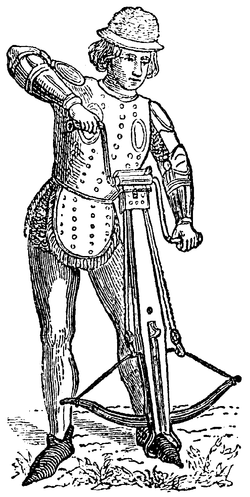
 Iron cranequin, South German, late 15th century
Iron cranequin, South German, late 15th century
Variants


Crossbows exist in different variants. One way to classify them is the acceleration system, while another is the size and energy, degree of automation or projectiles.
A recurve crossbow is a bow that has tips curving away from the archer. The recurve bow's bent limbs have a longer draw length than an equivalent straight-limbed bow, giving more acceleration to the projectile and less hand shock. Recurved limbs also put greater strain on the materials used to make the bow, and they may make more noise with the shot.
Multiple bow systems have a special system of pulling the sinew via several bows (which can be recurve bows). The workings can be compared to a modern compound bow system. The weapon uses several different bows instead of one bow with a tackle system to achieve a higher acceleration of the sinew via the multiplication with each bow's pulling effect.
A compound crossbow is a modern crossbow and is similar to a compound bow. The limbs are usually much stiffer than those of a recurve crossbow. This limb stiffness makes the compound bow more energy efficient than other bows, but the limbs are too stiff to be drawn comfortably with a string attached directly to them. The compound bow has the string attached to the pulleys, one or both of which has one or more cables attached to the opposite limb. When the string is drawn back, the string causes the pulleys to turn. This causes the pulleys to pull the cables, which in turn causes the limbs to bend and thus store energy. Other types of compound bows use either (one or both) cam shaped or eccentrically mounted pulleys in order to provide a "let off", such that the archer is not holding against the maximum draw weight of the bow while trying to aim. But in a crossbow the string is held back mechanically, so there is no advantage in providing a let off. Therefore, compound crossbows generally use only pulleys that are both round and concentrically mounted, in order to capture the maximum available energy from the relatively short draw length.
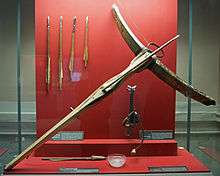
The smallest crossbows are pistol crossbows. Others are simple long stocks with the crossbow mounted on them. These could be shot from under the arm. The next step in development was stocks of the shape that would later be used for firearms, which allowed better aiming. The arbalest was a heavy crossbow which required special systems for pulling the sinew via windlasses. For siege warfare the size of crossbows was further increased to hurl large projectiles such as rocks at fortifications. The required crossbows needed a massive base frame and powerful windlass devices. Such devices include the oxybeles. The ballista has torsion springs replacing the elastic prod of the oxybeles, but later also developed into smaller versions.[6] "Ballista" is still the root word for crossbow in Romance languages such as Italian (balestra) and Spanish (ballesta).
The repeating crossbow automated the separate actions of stringing the bow, placing the projectile and shooting. This way the task can be accomplished with a simple one-handed movement, while keeping the weapon stationary. As a result, it is possible to shoot at a faster rate compared to an unmodified version. The Greek Polybolos was an ancient repeating ballista reputedly invented by Dionysius of Alexandria in the 3rd century BC. The Chinese repeating crossbow, Chu Ko Nu, is a handheld crossbow that accomplishes the task with a magazine containing a number of bolts on top. The mechanism is worked by moving a rectangular lever forward and backward. The weapon was mainly used as a weapon against lightly armored soldiers, since it shot small bolts that were often dipped in poison.
A bullet crossbow is a type of handheld crossbow which rather than arrows or bolts shoots spherical projectiles made of stone, clay or lead. There are two variants; one has a double string with a pocket for the projectile, and the other has a barrel with a slot for the string.
A slurbow is a type of crossbow with a wood or metal barrel over the top of the stock that is arguably influenced by the emergence of the pistol.
 Cocking of a Greek gastraphetes
Cocking of a Greek gastraphetes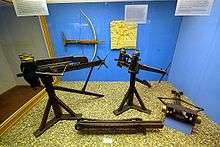 Arsenal of ancient mechanical artillery in the Saalburg, Germany; left: polybolos reconstruction by the German engineer Erwin Schramm (1856-1935)
Arsenal of ancient mechanical artillery in the Saalburg, Germany; left: polybolos reconstruction by the German engineer Erwin Schramm (1856-1935) Chinese Chuangzi Nu stationary windlass device with triple-bow arcuballista
Chinese Chuangzi Nu stationary windlass device with triple-bow arcuballista Chinese repeating crossbow with pull lever and automatic reload magazine
Chinese repeating crossbow with pull lever and automatic reload magazine Chinese Lian Nu (連弩), multiple shot crossbow without a visible nut or cocking aid
Chinese Lian Nu (連弩), multiple shot crossbow without a visible nut or cocking aid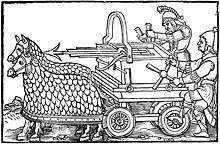 Early modern four-wheeled ballista drawn by armored horses (1552)
Early modern four-wheeled ballista drawn by armored horses (1552)- 16th-century French mounted crossbowman ("cranequinier"). His crossbow is drawn with a rack-and-pinion "cranequin", so it can be used while riding.
 Pistol crossbow for home recreational shooting. Made by Frédéric Siber in Morges, early 19th century. On display at Morges military museum.
Pistol crossbow for home recreational shooting. Made by Frédéric Siber in Morges, early 19th century. On display at Morges military museum. French cross-bow grenade thrower Arbalète sauterelle type A d'Imphy circa 1915
French cross-bow grenade thrower Arbalète sauterelle type A d'Imphy circa 1915
Projectiles
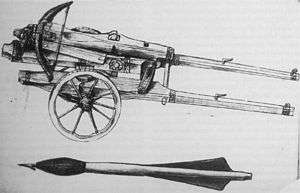

The arrow-like projectiles of a crossbow are called bolts. These are much shorter than arrows, but can be several times heavier. There is an optimum weight for bolts to achieve maximum kinetic energy, which varies depending on the strength and characteristics of the crossbow, but most could pass through common mail. In ancient times the bolts of a strong crossbow were usually several times heavier than arrows. Modern bolts are stamped with a proof mark to ensure their consistent weight and do not have fletching, i.e. feathered ends like those commonly seen on arrows.[7] Crossbow bolts can be fitted with a variety of heads, some with sickle-shaped heads to cut rope or rigging; but the most common today is a four-sided point called a quarrel. A highly specialized type of bolt is employed to collect blubber biopsy samples used in biology research.
Most modern crossbows are designed to shoot arrows instead of bolts.[7] Crossbow arrows are of similar construction to ordinary bow arrows, just shorter in length because of reduced power stroke.
Crossbows can also be adapted to shoot lead bullets or rocks, in which case they are called stone-bows. Primarily used for hunting wildfowl, these usually have a double string with a pouch between the strings to hold the projectile.
Even relatively small differences in arrow weight can have a considerable impact on its drop and, conversely, its flight trajectory.[8]
Accessories
The ancient Chinese crossbow often included a metal (i.e. bronze or steel) grid serving as iron sights. Modern crossbow sights often use similar technology to modern firearm sights, such as red dot sights and telescopic sights. Many crossbow scopes feature multiple crosshairs to compensate for the significant effects of gravity over different ranges. In most cases, a newly bought crossbow will need to be "sighted" for accurate shooting.[9]
Quivers can be mounted to hold ammunition. These are often made from plastic and usually hold the bolts in fixed positions along the structure. A popular detachable design consists of a main arm that is attached to the weapon, a plate on one end that secures four or more individual bolts at a point on their shafts and at the other end a cover that secures their heads. This kind of quiver is attached under the front of the crossbow, parallel to the string and is designed to be quickly detached and reattached. Other designs hold bolts underneath the crossbow parallel to the stock, sometimes on either side of the crossbow.
A major cause of the sound of shooting a crossbow is vibration of various components. Crossbow silencers are multiple components placed on high vibration parts, such as the string and limbs, to dampen vibration and suppress the sound of loosing the bolt.[10]
History
East Asia

The earliest evidence of crossbows in ancient China and neighboring peoples dates back to at least the 6th century BC. According to Sir Joseph Needham in his Science and Civilisation in China, it is not possible to pinpoint exactly which of the East Asian peoples invented the crossbow. Linguistically, it derives from non-Chinese languages of China's then neighbors in East Asia, who were often hired as marksmen mercenaries, while the first records and examples of representations as well as specimens are from China. However, there is unquestionable evidence that the crossbow was used for military purposes at least as far back as the Warring States period from the second half of the 4th century BC onwards.[11]
In terms of archaeological evidence, bronze crossbow bolts dating from as early as the mid-5th century BC have been found at a Chu burial site in Yutaishan, Hubei.[12] The earliest handheld crossbow stocks with bronze trigger, dating from the 6th century BC, were found in Tomb 3 and 12 at Qufu, Shandong, previously the capital of Lu.[13][14] Other early finds of crossbows were discovered in Tomb 138 at Saobatang, Hunan, dating to the mid-4th century BC.[15][16] Ammunition for crossbows could have also been spherical. In discussing the astronomical topics such as solar and lunar eclipses, the Western-Han era mathematician and music theorist Jing Fang (78-37 BC) wrote that the moon, shaped like a ball, produced no light and was illuminated only by the sun, which he compared to the shape of a round crossbow bullet.[17]
Repeating crossbows, first mentioned in the Records of the Three Kingdoms, were discovered in 1986 in Tomb 47 at Qinjiazui, Hubei, and were dated to around the 4th century BC.[18] The earliest Chinese document mentioning a crossbow were texts from the 4th to 3rd centuries BC attributed to the followers of Mozi. Sun Tzu's influential treatise on war, The Art of War (first appearance dated to sometime between 500 BC to 300 BC[19]) refers in chapter five to the traits of crossbows and in chapter twelve, to the usage of crossbows.[20] One of the earliest reliable descriptions of this weapon in warfare is of an ambush in 341 BC, the Battle of Ma-Ling. In the opinion of one authority, the crossbow (Chinese: 弩; pinyin: nǔ) had become "nothing less than the standard weapon of the Han armies" by the 2nd century BC.[21]
The earliest textual evidence of the handheld crossbow used in battle dates to the 4th century BC.[22] Handheld crossbows with complex bronze trigger mechanisms have also been found with the Terracotta Army in the tomb of Qin Shihuang (r. 221–210 BC) that are similar to specimens from the subsequent Han Dynasty (202 BC–220 AD), while crossbowmen described in the Qin and Han Dynasty learned drill formations, some were even mounted as cavalry units, and Han Dynasty writers attributed the success of numerous battles against the Xiongnu to massed crossbow volleys.[23][24] The bronze triggers were designed in such a way that they were able to store a large amount of energy within the bow when drawn, but was easily shot with little recoil when the trigger were pulled (this allowed it for precision shooting). The metal portions of the crossbow were also mass-produced with precision, with the bronze mechanisms being interchangeable. Finally, the Qin and Han Dynasties also developed crossbow shooting lines, with alternating rows of crossbowmen shooting and reloading in a manner similar to a musket firing line.
In Vietnamese historical legend, the ruler and general Thục Phán who ruled over the ancient kingdom of Âu Lạc from 257 to 207 BC is said to have owed his power to a magic crossbow, capable of shooting thousands of bolts at once.
Crossbow technology for multi-proded crossbows was transferred from the Chinese to Champa, which Champa used in its invasion of the Khmer Empire's Angkor in 1177. China transferred crossbow technology to Champa.[25] When the Chams sacked Angkor they used the Chinese siege crossbow.[26][27] Crossbows were given to the Chams by China.[28] Crossbows and archery while mounted were instructed to the Cham by a Chinese in 1171.[29]
Different varieties of crossbows were also developed, such as the repeating crossbow, multi-shot crossbow, and repeating multi-shot crossbow.
Ancient Greece

The earliest reasonably reliable date for the utilization of crossbows in Europe is in ancient Greece from the 5th century BC.[30] The historian Diodorus Siculus (fl. 1st century BC), described the invention of a mechanical arrow shooting catapult (katapeltikon) by a Greek task force in 399 BC.[31][32] According to the inventor Hero of Alexandria (fl. 1st century AD), who referred to the now lost works of the 3rd-century BC engineer Ctesibius, this weapon was inspired by an earlier hand crossbow, called the gastraphetes (belly shooter), which could store more energy than the Greek bows. A detailed description of the gastraphetes, along with a drawing, is found in Heron's technical treatise Belopoeica.[33][34] The gastraphetes was powered by a composite bow. It was cocked by resting the stomach in a concavity at the rear of the stock and pressing down with all strength. In this way considerably more energy can be summoned up than by using only one arm of the archer as in the hand-bow. The heavy weight and bulk of the gastraphetes may have necessitated a prop to keep it standing, i.e. by mounting it on a defensive wall or using a portable prop.[35]
A third Greek author, Biton (fl. 2nd century BC), whose reliability has been positively reevaluated by recent scholarship,[32][36] described two advanced forms of the gastraphetes, which he credits to Zopyros, an engineer from southern Italy. Zopyrus has been plausibly equated with a Pythagorean of that name who seems to have flourished in the late 5th century BC.[37][38] He probably designed his bow-machines on the occasion of the sieges of Cumae and Milet between 421 BC and 401 BC.[39][40] The bows of these machines already featured a winched pull back system and could apparently throw two missiles at once.[41]
From the mid-4th century BC onwards, evidence of the Greek use of crossbows becomes more dense and varied: Arrow-shooting machines (katapeltai) are briefly mentioned by Aeneas Tacticus in his treatise on siegecraft written around 350 BC.[41] An Athenian inventory from 330–329 BC includes catapults bolts with heads and flights.[42] Arrow-shooting machines in action are reported from Philip II's siege of Perinthos in Thrace in 340 BC.[43] At the same time, Greek fortifications began to feature high towers with shuttered windows in the top, presumably to house anti-personnel arrow shooters, as in Aigosthena.[44]
The transition to torsion catapults, which are not considered crossbows and came to dominate Greek and Roman artillery design, is first evident in inventories of the Athenian arsenal from between 338 and 326 BC.[41][42]
Roman Empire

The ancient world knew a variety of mechanical hand-held weapons similar to the later medieval crossbow. The exact terminology is a subject of continuing scholarly debate. Roman authors like Vegetius (fl. 4th century) note repeatedly the use of arrow shooting weapons such as arcuballista and manuballista respectively cheiroballista. While most scholars agree that one or more of these terms refer to handheld mechanical weapons, there is disagreement whether these were flexion bows or torsion powered like the recent Xanten find.[45]
The Roman commander Arrian (c. 86 – after 146) records in his Tactica Roman cavalry training for shooting some mechanical handheld weapon from horseback.[46] Sculptural reliefs from Roman Gaul depict the use of crossbows in hunting scenes. These are remarkably similar to the later medieval crossbow.[47]
Medieval Europe
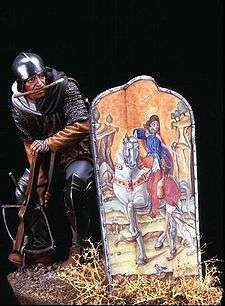
The crossbow is portrayed as a hunting weapon on four Pictish stones from early medieval Scotland (6th to 9th centuries): St. Vigeans no. 1, Glenferness, Shandwick, and Meigle.[48] The use of crossbows in European warfare is again evident from the Battle of Hastings until about the year 1500. They almost completely superseded hand bows in many European armies in the 12th century for a number of reasons. In modern tests, longbows showed a higher rate of shot than crossbows of the same energy, due to the difficulty of the shooter in handling the mechanical parts for loading in the same time as the bow was pulled. With lots of training, a longbowman can achieve a high degree of accuracy that is comparable to the much steeper learning curve in aimed shooting with the crossbow. Despite strength training, there are physical limits to the longbow, unlike the crossbow, which can store several times the energy, but will be less efficient in translating stored into kinetic energy due to the thicker spring material. There is no record from the Middle Ages comparing longbowmen and crossbowmen shooting in one army from a similar position, although such occasions are known with visiting Englishmen in the Baltic and Scots in the French army.
In the armies of Europe,[49] mounted and unmounted crossbowmen, often mixed with slingers, javelineers and archers, occupied a central position in battle formations. Usually they engaged the enemy in offensive skirmishes before an assault of mounted knights. Crossbowmen were also valuable in counterattacks to protect their infantry. The rank of commanding officer of the crossbowmen corps was one of the highest positions in any army of this time. Along with polearm weapons made from farming equipment, the crossbow was also a weapon of choice for insurgent peasants such as the Taborites.
Mounted knights armed with lances proved ineffective against formations of pikemen combined with crossbowmen whose weapons could penetrate most knights' armor. The invention of pushlever and ratchet drawing mechanisms enabled the use of crossbows on horseback, leading to the development of new cavalry tactics. Knights and mercenaries deployed in triangular formations, with the most heavily armored knights at the front. Some of these riders would carry small, powerful all-metal crossbows of their own. Crossbows were eventually replaced in warfare by more powerful gunpowder weapons, although early guns had slower rates of fire and much worse accuracy than contemporary crossbows. Later, similar competing tactics would feature harquebusiers or musketeers in formation with pikemen (pike and shot), pitted against cavalry firing pistols or carbines.
Elsewhere

The Saracens called the crossbow qaws Ferengi, or "Frankish bow," as the Crusaders used the crossbow against the Arab and Turkic horsemen with remarkable success. The adapted crossbow was used by the Islamic armies in defence of their castles. Later footstrapped versions become very popular among the Muslim armies in Iberia. During the Crusades, Europeans were exposed to Saracen composite bows, made from layers of different material—often wood, horn and sinew—glued together and bound with animal tendon. These composite bows could be much more powerful than wooden bows, and were adopted for crossbow prods across Europe. Crossbow prods could be more easily waterproofed than hand bows, which was essential in the humid European climate.
In Western Africa and Central Africa,[50] crossbows served as a scouting weapon and for hunting, with enslaved Africans bringing this technology to natives in America.[51] In the American South, the crossbow was used for hunting and warfare when firearms or gunpowder were unavailable because of economic hardships or isolation.[51] In the North of Northern America, light hunting crossbows were traditionally used by the Inuit.[52] These are technologically similar to the African derived crossbows, but have a different route of influence.
The native Montagnards of Vietnam's Central Highlands were also known to have used crossbows, as both a tool for hunting, and later, an effective weapon against the Viet Cong during the Vietnam War. Montagnard fighters armed with crossbows proved a highly valuable asset to the US Special Forces operating in Vietnam, and it was not uncommon for the Green Berets to integrate Montagnard crossbowmen into their strike teams.[53]
Modern use
Hunting, leisure and science

Crossbows are used for shooting sports and bowhunting in modern archery and for blubber biopsy samples in scientific research. In some countries such as Canada or the United Kingdom, they may be less heavily regulated than firearms, and thus more popular for hunting; some jurisdictions have bow and/or crossbow only seasons.[54]
Modern military and paramilitary use
In modern times, crossbows are no longer used for assassinations, but there are still some applications. For example, in the Americas, the Peruvian army (Ejército) equips some soldiers with crossbows and rope, to establish a zip-line in difficult terrain.[55] In Brazil the CIGS (Jungle Warfare Training Center) also trains soldiers in the use of crossbows.[56][57] In the United States, SAA International Ltd manufacture a 150 ft·lb crossbow-launched version of the U.S. Army type classified Launched Grapnel Hook (LGH), among other mine countermeasure solutions designed for the middle-eastern theatre. It has been successfully evaluated in Cambodia and Bosnia.[58] It is used to probe for and detonate tripwire initiated mines and booby traps at up to 50 meters. The concept is similar to the LGH device originally only fired from a rifle, as a plastic retrieval line is attached.[59] Reusable up to 20 times, the line can be reeled back in without exposing oneself. The device is of particular use in tactical situations where noise discipline is important.[60]

In Europe, British-based Barnett International supplied crossbows to Serbian forces which according to The Guardian were later used "in ambushes and as a counter-sniper weapon", against the Kosovo Liberation Army during the Kosovo War in the areas of Pec and Djakovica, south west of Kosovo.[61] Whitehall launched an investigation, though the department of trade and industry established that not being "on the military list" crossbows were not covered by such export regulations. Paul Beaver of Jane's defence publications commented that, "They are not only a silent killer, they also have a psychological effect". On 15 February 2008 Serbian Minister of Defence Dragan Sutanovac was pictured testing a Barnett crossbow during a public exercise of the Serbian army's Special Forces in Nis, 200 km south of capital Belgrade.[62] Special forces in both Greece and Turkey also continue to employ the crossbow.[63][64] Spain's Green Berets still use the crossbow as well.[65]
In Asia, some Chinese armed forces use crossbows, including the special force Snow Leopard Commando Unit of the People's Armed Police and the People's Liberation Army. One justification for this comes in the crossbow's ability to stop persons carrying explosives without risk of causing detonation.[66] During the Xinjiang riots of July 2009, crossbows were used alongside modern military hardware to quell protests.[67] The Indian Navy's Marine Commando Force were equipped until the late 1980s with crossbows supplied with cyanide-tipped bolts, as an alternative to suppressed handguns.[68]
Comparison to conventional bows
With a crossbow, archers could release a draw force far in excess of what they could have handled with a bow. Furthermore, the crossbow could hold the tension for a long time, whereas even the strongest longbowman could only hold a drawn bow for so long. The ease of use of a crossbow allows it to be used effectively with little training, while other types of bows take far more skill to shoot accurately. The disadvantage is the greater weight and clumsiness compared to a bow, as well as the slower rate of shooting and the lower efficiency of the acceleration system, but there would be reduced elastic hysteresis, making the crossbow a more accurate weapon.
Crossbows have a much smaller draw length than bows. This means that for the same energy to be imparted to the arrow (or bolt), the crossbow has to have a much higher draw weight.
A direct comparison between a fast hand-drawn replica crossbow and a longbow show a 6:10 rate of shooting[69] or a 4:9 rate within 30 seconds and comparable weapons.[70]
Legal issues
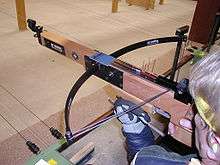
Can. 29 of the Second Lateran Council under Pope Innocent II in 1139 banned the use of crossbows, as well as slings and bows, against Christians.[71]
Today, the crossbow often has a complicated legal status due to the possibility of lethal use and its similarities to both firearms and archery weapons. While some jurisdictions regard crossbows the same as firearms, many others do not require any sort of license to own a crossbow. The legality of using a crossbow for hunting varies widely around the world, and even within different jurisdictions of some federal countries.
For example, in Canada you do not need a valid licence or registration certificate to possess any other type of bow, including a crossbow that is longer than 500 mm and that requires the use of both hands.[72]
See also
- Arbalist (crossbowman)
- Bow (weapon)
- History of crossbows
- Master of Crossbowmen
- Modern competitive archery and target archery for bows
- Shooting sport
Notes
- ↑ Payne-Gallwey, Ralph (2007) [1903], The Crossbow, Skyhorse Publishing Inc., p. 2, ISBN 1-60239-010-X
- ↑ Tom Ukinski (23 May 2013). "Drones: Mankind's Always Had Them". Guardian Liberty Voice. Retrieved 1 March 2015.
- ↑ "Facts and interesting information about Medieval Weapons, Armor and arms, specifically, the Crossbow". medieval-life-and-times.info. Retrieved 1 March 2015.
- ↑ Hanafi et al. 2011: 23
- ↑ Cranequin
- ↑ O'Connell, Robert L. (1989). Of Arms and Men: A History of War, Weapons, and Aggression. Oxford University Press. ISBN 0-19-505359-1, p. 65
- 1 2 Bolts and Arrows: The Lighter Side of Hunting Projectile Name Calling. Foremosthunting.com. Retrieved on 24 June 2011.
- ↑ Crossbow Arrow Drop - Charted Test Results. BestCrossbowSource.com
- ↑ "Sighting a Crossbow". Best Crossbow Source. Retrieved 28 October 2014.
- ↑ "Crossbow". reference.com. Columbia University Press. Retrieved 1 March 2015.
- ↑ Needham, Joseph (2004), Science and Civilisation in China, Vol 5 Part 6, Cambridge University Press, p. 135, ISBN 0-521-08732-5
- ↑ Wagner (1993), 153, 157–158.
- ↑ You (1994), 80.
- ↑ A Crossbow Mechanism with Some Unique Features from Shandong, China. Asian Traditional Archery Research Network. Retrieved on 20 August 2008.
- ↑ Mao (1998), 109–110.
- ↑ Wright (2001), 159.
- ↑ Needham, Joseph (1986). Science and Civilization in China: Volume 3, Mathematics and the Sciences of the Heavens and the Earth. Taipei: Caves Books Ltd, p. 227.
- ↑ Lin (1993), 36.
- ↑ James Clavell, The Art of War, prelude
- ↑ Sun Tzu, The Art Of War
- ↑ Graff 2002, p. 22.
- ↑ Wright (2001), 42.
- ↑ Needham (1986), Volume 5, Part 6, 124–128.
- ↑ Lewis (2000a), 45.
- ↑ R. G. Grant (2005). Battle: A Visual Journey Through 5,000 Years of Combat. DK Pub. p. 100. ISBN 978-0-7566-1360-0.
- ↑ Stephen Turnbull (20 August 2012). Siege Weapons of the Far East (1): AD 612-1300. Osprey Publishing Limited. pp. 42–. ISBN 978-1-78200-225-3.
- ↑ Stephen Turnbull (20 August 2012). Siege Weapons of the Far East (1): AD 612–1300. Bloomsbury Publishing. pp. –. ISBN 978-1-78200-225-3.
- ↑ Joseph Needham; Ling Wang; Robin D. S. Yates; Gwei-Djen Lu; Ping-Yü Ho (1994). Science and Civilisation in China: Vol. 5, Chemistry and chemical technology ; Pt. 6, Military technology : missiles and sieges. Cambridge University Press. pp. 145–. ISBN 978-0-521-32727-5.
- ↑ Stephen Turnbull (20 August 2012). Siege Weapons of the Far East (1): AD 612–1300. Bloomsbury Publishing. pp. –. ISBN 978-1-78200-225-3.
- ↑ Gurstelle, William (2004).The Art of the Catapult. Chicago Review Press. ISBN 1-55652-526-5, p. 49
- ↑ Diod. Sic. 14.42.1
- 1 2 Duncan Campbell: Greek and Roman Artillery 399 BC-AD 363, Osprey Publishing, Oxford 2003, ISBN 1-84176-634-8, p.3
- ↑ Duncan Campbell: Greek and Roman Artillery 399 BC-AD 363, Osprey Publishing, Oxford 2003, ISBN 1-84176-634-8, p.4
- ↑ Stanley M. Burstein, Walter Donlan, Sarah B. Pomeroy, and Jennifer Tolbert Roberts (1999). Ancient Greece: A Political, Social, and Cultural History. Oxford University Press. ISBN 0-19-509742-4, p. 366
- ↑ Campbell (2003), 4.
- ↑ M.J.T. Lewis: When was Biton?, Mnemosyne, Vol. 52, No. 2 (1999), pp. 159–168
- ↑ Peter Kingsley: Ancient Philosophy, Mystery and Magic, Clarendon Press, Oxford 1995, p.150ff. Plato.stanford.edu. Retrieved on 24 June 2011.
- ↑ Lewis established a lower date of no later than the mid-4th century (M.J.T. Lewis: When was Biton?, Mnemosyne, Vol. 52, No. 2 (1999), pp. 159–168 (160)). Same de Camp (L. Sprague de Camp: Master Gunner Apollonios, Technology and Culture, Vol. 2, No. 3 (1961), pp. 240–244 (241)
- ↑ Biton Biton 65.1–67.4 & 61.12–65.1
- ↑ Duncan Campbell: Greek and Roman Artillery 399 BC-AD 363, Osprey Publishing, Oxford 2003, ISBN 1-84176-634-8, p.5
- 1 2 3 Duncan Campbell: Greek and Roman Artillery 399 BC-AD 363, Osprey Publishing, Oxford 2003, ISBN 1-84176-634-8, p.8ff.
- 1 2 Eric William Marsden: Greek and Roman Artillery: Historical Development, The Clarendon Press, Oxford 1969, ISBN 978-0-19-814268-3, p.57
- ↑ Eric William Marsden: Greek and Roman Artillery: Historical Development, The Clarendon Press, Oxford 1969, ISBN 978-0-19-814268-3, p.60
- ↑ Josiah Ober: Early Artillery Towers: Messenia, Boiotia, Attica, Megarid, American Journal of Archaeology, Vol. 91, No. 4. (1987), S. 569–604 (569)
- ↑ Romanhideout.com: Manuballista found near Xanten
- ↑ Arrian Tact. 43.1; Baatz 1999, pp. 11–15; Campbell 1986, pp. 117–132
- ↑ Dictionnaire des antiquites grecques et romaines: Arcuballista, Manuballista
- ↑ John M. Gilbert, Hunting and Hunting Reserves in Medieval Scotland (Edinburgh: John Donald, 1979), p. 62.
- ↑ Verbruggen, J.F; Second revised and enlarged, edition, in English translation (1997), The art of warfare in Western Europe during the Middle Ages, Boydell&Brewer, ISBN 0-85115-570-7
- ↑ Baaka pygmy with crossbow. Photographersdirect.com. Retrieved on 24 June 2011.
- 1 2 Notes On West African Crossbow Technology. Diaspora.uiuc.edu. Retrieved on 24 June 2011.
- ↑ Hunting Network (10 February 2009). "The Crossbow: Four thousand years of traditional archery". bowhunting.com. Retrieved 1 March 2015.
- ↑ John Friedman. "The Crossbow History". www.cacciaebalestra.altervista.org. Retrieved 1 March 2015.
- ↑ https://dr6j45jk9xcmk.cloudfront.net/documents/3311/2014-ontario-hunting-regulations.pdf
- ↑ Ejercito prepare for deployment.
- ↑ CIGS information thread.
- ↑ CIGS photograph.
- ↑ Jane's LGH Mine Clearance by US forces Jul 2009. Janes.com (9 June 2011). Retrieved on 24 June 2011.
- ↑ LGH Plastic Retrieval Line. None. Retrieved on 24 June 2011.
- ↑ SAA Crossbow Launched Grapnel Hook Archived 15 July 2011 at the Wayback Machine.. Saa-intl.com. Retrieved on 24 June 2011.
- ↑ The Guardian.
- ↑ Day Life Serbia report. Daylife.com (15 February 2008). Retrieved on 24 June 2011.
- ↑ Greek soldiers uses crossbow.
- ↑ Turkish special ops.
- ↑ Spanish Green Beret 2005 photo.
- ↑ New crossbow shoots with great accuracy, archived from the original on 2 February 2014
- ↑ Bingham, John. (9 July 2009) "Xinjiang riots: Modern Chinese army displays ancient preference for crossbow". Daily Telegraph (UK). Retrieved on 24 June 2011.
- ↑ Marine Commandos[dead link]
- ↑ Video comparing longbow and crossbow Retrieved 16 September 2010
- ↑ longbow vs crossbow behind a pavese Retrieved 16 September 2010
- ↑ The sources are collected in Hefele, Histoire des conciles d'apres les documents originaux, trans. and continued by H. Leclerq 1907–52., 5/1, 721–722; but see also, Bernhardi Jahrbuecher der deutschen Geschichte, I Leipzig 1883, 154–160: Tenth Ecumenical Council: Lateran II 1139, Internet Medieval Source Book, 1 November 1996, retrieved 5 May 2007
- ↑ http://www.rcmp-grc.gc.ca
[1] http://www.papalencyclicals.net/Councils/ecum10.htm Retrieved 11/2/2015 ----- 29. We prohibit under anathema that murderous art of crossbowmen and archers, which is hateful to God, to be employed against Christians and Catholics from now on.
References
- Baatz, Dietwulf (1994), "Die römische Jagdarmbrust", Bauten und Katapulte des römischen Heeres, Stuttgart: Franz Steiner Verlag, pp. 284–293, ISBN 3-515-06566-0
- Graff, David A. (2002), Medieval Chinese Warfare, 300-900, Warfare and History, London: Routledge, ISBN 0415239559
- Payne-Gallwey, Ralph, Sir, The Crossbow: Mediaeval and Modern, Military and Sporting; its Construction, History & Management with a Treatise on the Balista and Catapult of the Ancients and An Appendix on the Catapult, Balista & the Turkish Bow, New York : Bramhall House, 1958.
- The Crossbows of South-West China, by Stephen Selby, 1999
- African crossbow, Donald B. Ball, 1996
- Crossbow of the Hill Tribes
External links
| Wikimedia Commons has media related to Crossbows. |
| Look up crossbow in Wiktionary, the free dictionary. |
- How To Make A Crossbow - Online Video Course
- International Crossbow Shooting Union (IAU)
- World Crossbow Shooting Association (WCSA)
- The Crossbow by Sir Ralph Payne-Gallwey, BT
- Designing crossbows
- Choosing The Best Crossbow For The Money


